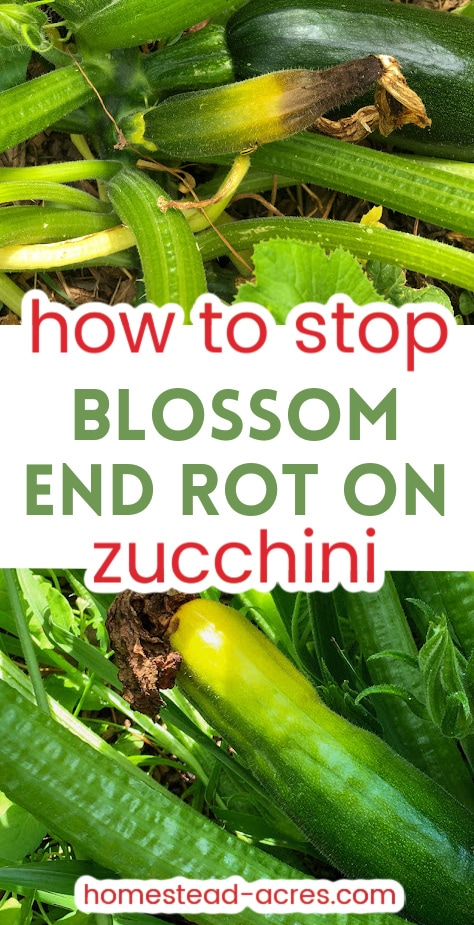This post may contain affiliate links, my full disclosure can be read here. As an Amazon Associate I earn from qualifying purchases.
Are your zucchinis turning yellow and black and rotting on the flower end? It’s probably zucchini blossom end rot causing the zucchini fruit to rot and die. Find out what causes blossom end rot and how to treat it.
I know it can feel so frustrating when you’ve been caring for your zucchini plants, watching them start to flower, and then your squash rots.
Leaving you staring at your plants wondering why are my zucchini turning yellow and rotting.
But zucchini blossom end rot is a very common problem. You probably think of it most often as a tomato plant problem.
But it doesn’t just happen to tomato plants it’s also commonly found in peppers, eggplant, and squash.
It’s simply caused by a lack of calcium. But the solution isn’t to just start adding calcium to your soil because it likely has enough already.
Rather your plants are struggling to absorb enough calcium.
Thankfully this can be fixed with a few simple steps. So if you want to save your zucchini harvest let’s look at what’s causing the problem and how to treat it.
What does blossom end rot look like in zucchini?

Blossom end rot is easy to identify in green zucchini, and a little harder in the early stages with yellow zucchini because of the color.
At first, your squash may look healthy but it will develop a dark spot on the blossom end.
As it spreads the bottom 2 to 4 inches of the fruit will turn yellow, then brown, and finally black in color.
The skin will start to wrinkle and shrivel and feel soft and mushy. This can happen on young developing fruit with the female flowers still attached or on larger zucchini. But the damage always starts at the blossom end of the fruit.
What Causes Blossom End Rot In Zucchini?
When you see your squash rotting your first thought might be that a pest or disease has invaded your garden. But this damage isn’t caused by mold, a fungal disease, or even the nasty squash bugs.
Blossom end rot in zucchini and squash plants is caused by a calcium deficiency.
But most of the time it’s not because your soil is lacking calcium, it’s inconsistent watering just like blossom end rot in tomatoes and other plants.
When the summer heat arrives your plants start to grow quickly. But if you aren’t getting enough rainfall and irrigation is lacking the plants roots can’t absorb enough calcium from the soil.
But if your zucchini plants are getting enough water you could have some problems that cause your plants root damage.
If you’ve had a very rainy growing season causing wet soil conditions your plants could be suffering from root rot. Of course, if the plants roots are dying it will affect the plant’s ability to absorb calcium from the soil.
Pests like nematodes will also eat plant roots causing stress and damage. But simply weeding too close and too deep to your plants can also cut their roots.

Do I Need To Add Calcium To My Soil?
I know when you have a problem with your garden plants you want to jump in and fix it. Many suggest using Tums for blossom end rot because they are an easy to get calcium source.
But you don’t need to start adding antacid tablets to your garden.
Most of the time there really is no need to add extra calcium to your soil. But if you’re concerned that you might have low soil calcium levels have a soil test done and then you’ll know if it’s lacking minerals.
If you do need to add calcium to your soil garden lime, wood ash, and bone meal are good options.
What About Epsom Salt?
I know, one of the most common garden tips is to use Epsom salt to stop or prevent blossom end rot in zucchini and other plants. But it’s not a good idea.
Epsom salts contain magnesium sulfate, not calcium. Magnesium can interfere with your plants ability to absorb calcium causing blossom end rot to get worse.
Can You Stop Blossom End Rot Once It Starts?

Once blossom end rot has started on your zucchini you can’t stop it from progressing on the affected fruits. But you can fix the conditions that are causing it to help save the rest of your crop.
How do you fix blossom end rot on zucchini plants?

First start by removing all damaged fruits from your zucchini plants. They won’t grow properly and the damage will only get worse.
The affected fruits will just keep trying to grow and take calcium and other resources away from the healthy fruit.
Watering
Since the most common cause of blossom end rot on zucchini is irregular watering the best way to fix your zucchini is to have the right soil moisture.
Zucchini grows best in soil that is evenly moist. You don’t want your plants growing in soggy soil or dry hard packed soil either.
Look back at how much rain you have received for the past few weeks. Has it been at least 1 inch of water each week?
If not you need to supplement by watering your garden. It’s common for us to get dry weather right when our plants start to produce flowers.
So take care to pay attention to the weather. Try to water consistently because the cycle of too dry and too wet is what causes stress to your plants.
Water plants deeply in the early morning to help your plants deal with extreme heat. Watering deeply will help encourage a good root system and quick plant growth.
Use soaker hoses or drip irrigation at the base of the plant if you can. This will help to put water right at the root zone and keep the plant leaves dry lowering the risk of powdery mildew.
Soil Type
But also consider what type of soil your plants are growing in. If you have heavy clay soil that compacts easily and stays waterlogged it’s going to cause root rot and blossom end rot problems for many of your plants.
Well-drained soil is ideal for your garden.
You can work at fixing your soil by adding a lot of organic matter over time. But to quickly improve your soil’s drainage raised beds or containers are a great option.
Remember that containers drain very quickly and in hot weather may need to be watered every day.
Mulch
Mulch around your squash plants to help the soil retain moisture better. This will help to keep the moisture level in the soil more steady and reduce your overall watering needs.
This is especially helpful if you have sandy soil or growing zucchini in containers.
Fertilizing
Avoid using high nitrogen fertilizers on your plants. Nitrogen can inhibit the plants uptake of calcium.
You end up with a beautiful plant with lush foliage but it ends up reducing your fruit production.
I’ve had good success by applying 1 to 2 inches of good-quality compost in the fall or early spring. Normally this is all the fertilizer that’s needed for healthy plants.
But if your plants are struggling use a natural liquid fertilizer that has phosphorus, and potash once the plants start blooming. This will help encourage flowering and root growth.
Avoid Root Damage
If you till your garden or use a hoe or other cultivator don’t use it too close to your plants. Instead, hand weed or mulch around them so you don’t disturb the roots.
Can you eat blossom end rot zucchini?
Zucchini with blossom end rot damage is generally considered ok to eat but you need to use your discretion. Obviously, if your zucchini looks off color, is softer than normal, or has a lot of rot it’s better tossed into the compost bin.
But if you have a nice sized zucchini with a small amount of damage on the end you can just cut off the bad section and use the rest. Just be aware that rot damage on the end can spread inside the zucchini and affect the taste and texture making it undesirable.
So carefully check each of your affected fruit.
While blossom end rot can be a real problem for zucchini plants the most common cause is a lack of water. The good news is that it’s easily fixed by watering consistently and this will help your plants calcium uptake to improve. With a little care, you will be harvesting lots of zucchini!

Connect With Homestead Acres!
Be sure to follow me on social media, so you never miss a post!
Facebook | Twitter | Pinterest | Twitter
Visit my Amazon store to find all my favorite gardening, homesteading tools, and gadgets plus all of my printed garden books and journals!

Kim Mills is a homeschooling mom of 6 and lives on an urban homestead in Ontario, Canada. Blogging at Homestead Acres she enjoys sharing tips to help you save money, grow and preserve your own food.



